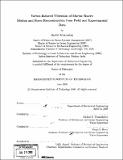Vortex-induced vibration of marine risers : motion and force reconstruction from field and experimental data
Author(s)
Mukundan, Harish
DownloadFull printable version (44.13Mb)
Alternative title
VIV of marine risers : motion and force reconstruction from field and experimental data
Other Contributors
Massachusetts Institute of Technology. Dept. of Mechanical Engineering.
Advisor
Michael S. Triantafyllou and Franz S. Hover.
Terms of use
Metadata
Show full item recordAbstract
Vortex-induced vibration (VIV) of long flexible cylindrical structures enduring ocean currents is ubiquitous in the offshore industry. Though significant effort has gone into understanding this complicated fluid-structure interaction problem, major challenges remain in modeling and predicting the response of such structures. The work presented in this thesis provides a systematic approach to estimate and analyze the vortex-induced motions and forces on a marine riser, and develop suitable methods to improve riser VIV modeling and response prediction. In the first part of the thesis, a systematic framework is developed, which allows reconstruction of the riser motion from a limited number of sensors placed along its length. A perfect reconstruction criterion is developed, which allows us to classify when the measurements from the sensors contain all information pertinent to VIV response, and when they do not, in which case additional, analytical methods must be employed. Reconstruction methods for both scenarios are developed and applied to experimental data. The methods are applied to: develop tools for in-situ estimation of fatigue damage on marine risers; improve understanding of the vortex shedding mechanisms, including the presence of traveling waves and higher-harmonic forces; and estimate the vortex-induced forces on marine risers. In the second part of the thesis, a method is developed to improve the modeling of riser VIV by extracting empirical lift coefficient databases from field riser VIV measurements. The existing experiment-based lift coefficient databases are represented in a flexible parameterized form using a set of carefully chosen parameters. Extraction of the lift coefficient parameters is posed as an optimization problem, where the error between the prediction using a theoretical model and the experimental data is minimized. (cont.) Predictions using the new databases are found to significantly reduce the error in estimating the riser cross-flow response. Finally, data from a comprehensive experiment is utilized to show that the riser response is resonant in the harmonic component, but non-resonant in the third-harmonic component. It is shown that this happens because the spatial dependence of the third-harmonic fluid force component is dominated by the first-harmonic wavelengths. This finding has significant implications for modeling the higher-harmonic forces and the resulting fatigue damage estimation methodologies.
Description
Thesis (Ph. D.)--Massachusetts Institute of Technology, Dept. of Mechanical Engineering, 2008. Includes bibliographical references (p. 199-205).
Date issued
2008Department
Massachusetts Institute of Technology. Department of Mechanical EngineeringPublisher
Massachusetts Institute of Technology
Keywords
Mechanical Engineering.